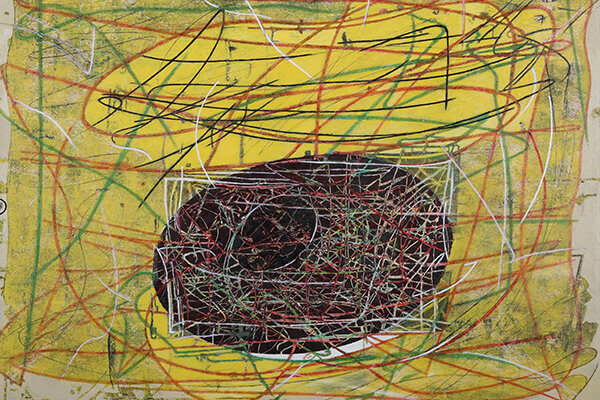PAT ADAMS AT THE BENNINGTON MUSEUM - A First Glimpse
Paintings by Pat Adams
Gatherum of Quiddities:
For sixty years Pat Adams has approached painting with an empiricist’s concern for the nature of visual form and the intimist’s sensibility that addresses the layered complexity of being. With abstract paintings characterized by seductive colors and richly encrusted surfaces, Pat seeks to bring from her “gatherum of quiddities” – that stew of unnamed qualities – a visual situation that bestirs contemplation."
From 1973 through 1976 Pat Adams was my professor at Bennington College. Pat already had 20 years of experience as a serious artist, showing in New York and collected by museums. The "landscape" for women artists was not an open one. The art world was both smaller and fairly closed to women. Things were changing, but most advances were hard won. I'm not really prepared to talk about what Pat was up against. All I can tell you is that until the 1980s, I believe, only two women had had a one person shows at the Guggenheim -- Helen Frankenthaler and Helen Frankenthaler.
Seeing Pat's paintings today I wonder why I didn't know them better; why I wasn't more aware of what she was thinking; what her process was; what battles she was waging on canvas. This retrospective at The Bennington Museum gave me a chance to experience her work and also see some of her materials: things she was looking at, tiny drawings she compiled endlessly in her notebooks. It was a revelation. It was the opening night and not the best opportunity to take in the work, but at the end of the evening, when the rooms emptied, I had a moment to look closely at some of the pieces with the director of the museum, Robert Wolterstorff.
I was struck by how my eyes were pulled around the canvas, how I felt moments of speed and slowness, of agitation and rest, of chaos and precision -- like I was entering the universe. I wondered at the surfaces. How she achieved tiny irregularly shaped dots in a grid, how she painted a curved line that was at once as precise as a calligrapher's curve, and yet broken in spots revealing the paint surface beneath. There was something so illogical about this line, so confounding, I couldn't figure out how it was made. When I was able to speak briefly with Pat during the show, she told me that some of the marks on the canvas were achieved by a kind of printing or transfer process. Painting on mylar and "stamping" it onto the canvas. But I didn't get a chance to ask her about the lines.
Pat's paintings are full of texture and unusual materials, mica, sand, pigment, and other minerals. Wolterstorff was most taken by this aspect of the work, which made him think of both Keifer's straw and Beuys' lard and felt. I forgot to mention to him that there was a Beuys exhibition at the college in the 1970s. As we looked at the paintings, the rigor of the composition struck both of us. To me, they felt like mathematical journeys. Jamie Franklin, the curator, had displayed some things that Pat had pulled elements from -- postcards of a Gothic Cathedral, the composition of an old Master painting, the shape of a sliced geode. All of these were echoed in the work.I believe that in the misogynistic days of the 1970s, these elements were at times dismissed as decorative. Seeing them now I know that they were no more decorative than the letters of a formula. What, after all, can be eliminated from E = mc 2 .





